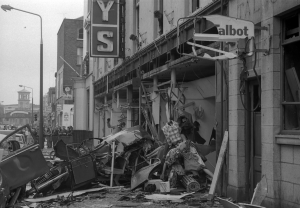Who bombed Dublin and Monaghan?
Published in Issue 3 (May/June 2014), Volume 22The most obvious suspects were loyalist paramilitaries, aiming to destroy power-sharing. Since 1969 loyalists had bombed Dublin and several border towns. Immediately after the bombings, Sammy Smyth of the UDA professed to be ‘very happy . . . There is a war with the Free State and now we are laughing at them’. Others suggested that the attacks were punishment because the South was a ‘safe haven’ for the IRA. Official Unionist MP John Laird claimed that the ‘people who are suffering [in Dublin] are people who have quietly condoned a terrorist campaign’. (This view, that the Irish government brought the bombings on themselves, was repeated by Ian Paisley in January 2014.) But both the UDA and the UVF initially denied responsibility for the attacks, with the UVF not admitting having carried them out until 1993. The sophistication of the operation also seemed beyond the capability of loyalists. Suspicions that the bombers were aided, and guided, by British military intelligence were aired almost immediately. These allegations formed the basis for a 1993 UTV documentary, ‘Hidden Hand: the Forgotten Massacre’, which heard British and Irish military veterans assert that it was unlikely that loyalists could have carried out the attack on their own. Former British intelligence officers Colin Wallace and Fred Holroyd, and a former RUC officer, John Weir, asserted that British security services had colluded in the bombings.
If this was the case, then it was a risky strategy. In December 1972 bombs in Dublin had forced the Dáil into accepting new security legislation. But by 1974 the coalition was cooperating with the British on security, even secretly supplying samples of captured IRA weapons. The cabinet included ministers such as Paddy Donegan, Paddy Cooney and Conor Cruise O’Brien, whose antipathy to the IRA rivalled that of any unionist. The two governments were also working together in support of the power-sharing executive. Carnage in Dublin could have provoked a ferocious anti-British backlash that would have destabilised the entire state.
Nevertheless, the British privately reflected after the bombings that even greater cooperation would result. Arthur Galsworthy noted that there was among Irish politicians a ‘much keener realisation of the Republic’s vulnerability to acts of terrorism spilling over from the North and recognition of the direct connection between this and continued violence by PIRA’. He also wrote that ‘Protestant opinion in the North must feel with some bitterness that it is only now that the South has experienced violence that they are reacting in the way the North sought for so long’. He warned, however, that it would be a ‘psychological mistake’ for British politicians to dwell on this, as ‘the Irish have taken the point’.

Guiney’s drapery on Talbot Street, where the second Dublin bomb exploded outside O’Neill’s shoe shop opposite at c. 5.30pm, killing fourteen people. (Dublin City Public Libraries)
















